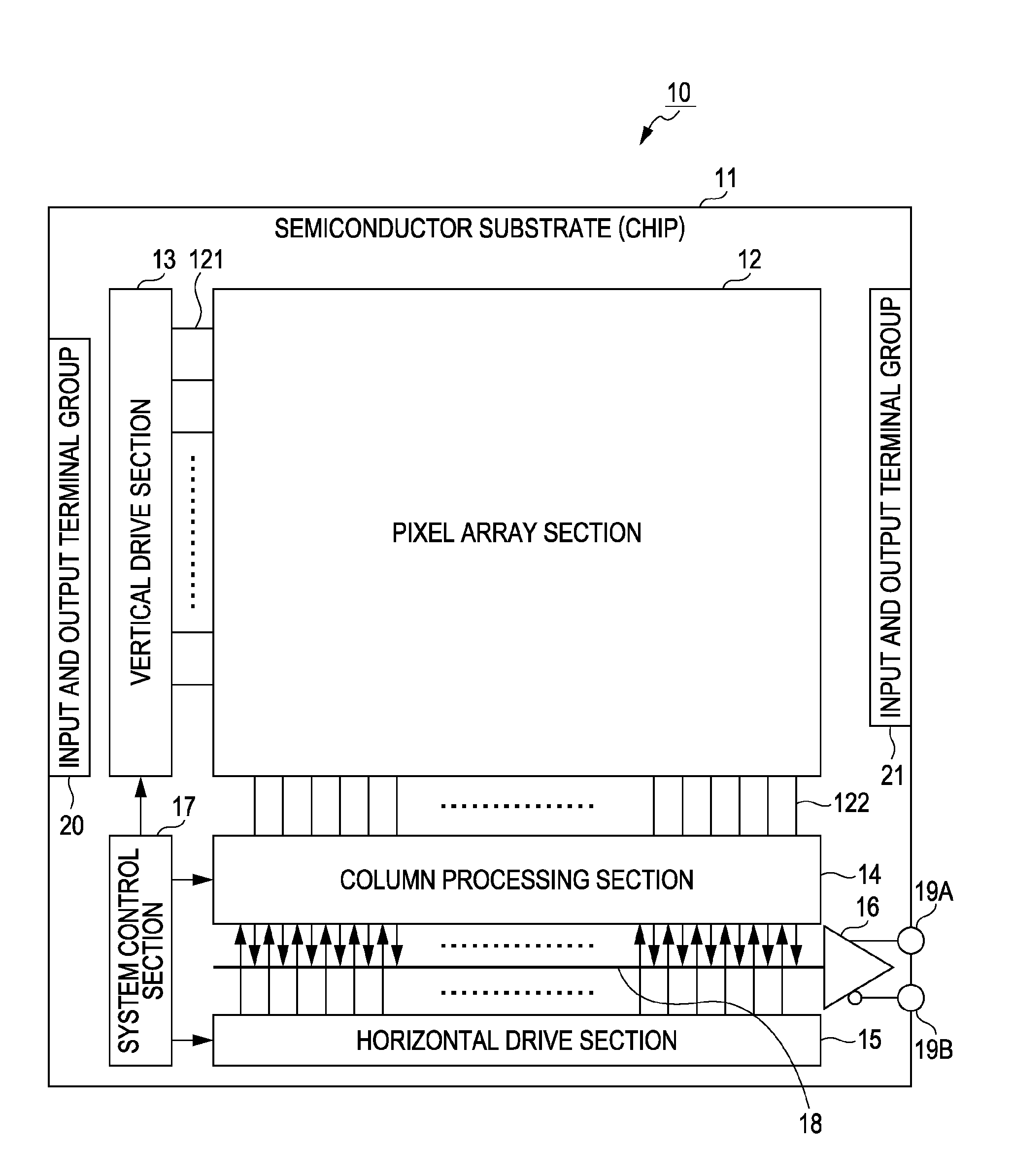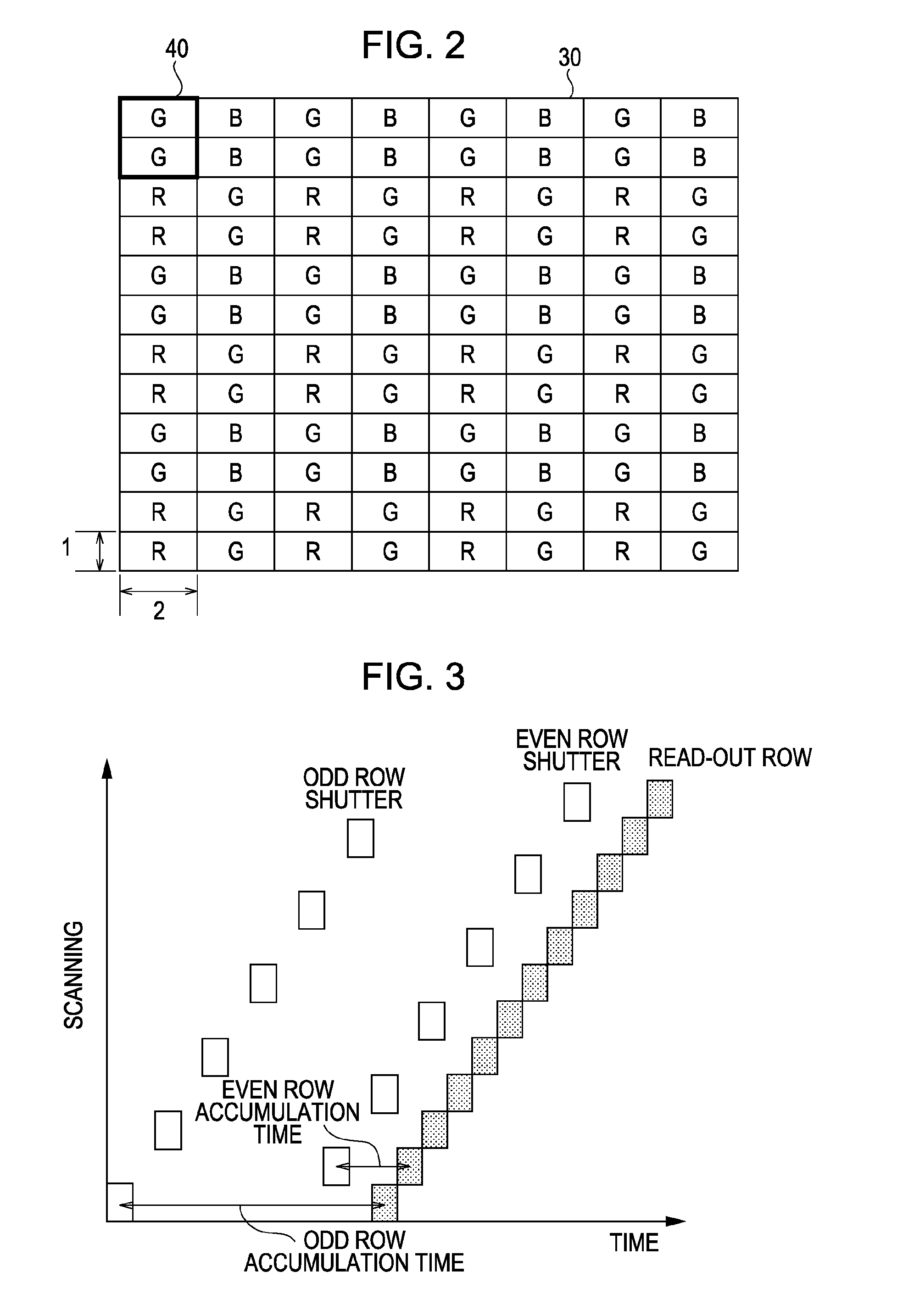Solid-state imaging device, signal processing method of solid-state imaging device, and electronic apparatus
a solid-state imaging and signal processing technology, applied in the direction of radioation controlled devices, television system scanning details, television systems, etc., can solve the problems of not increasing resolution, difficult to resolve a pixel pitch of 2 m or less, and difficult to resolve a pixel pitch of 5 m or less, so as to improve the imaging characteristic, improve the dynamic range, and improve the imaging characteristic
- Summary
- Abstract
- Description
- Claims
- Application Information
AI Technical Summary
Benefits of technology
Problems solved by technology
Method used
Image
Examples
first embodiment
[0067]FIG. 2 is a configuration diagram illustrating an example of the pixel array in the pixel array section 12 according to a first embodiment. As illustrated in FIG. 2, the pixel array section 12 includes unit pixels 30 each including a photoelectric conversion element and two-dimensionally arranged in multiple rows and columns. Herein, each of the unit pixels 30 is a so-called horizontally long rectangular pixel, which is twice as long in the horizontal size (in the row direction) as in the vertical size (in the column direction), i.e., which has a vertical-to-horizontal pitch ratio of 1:2.
[0068]If the CMOS image sensor 10 according to the present embodiment is capable of picking up a color image, color filters, e.g., on-chip color filters 40, are provided on respective light receiving surfaces of the unit pixels 30. Herein, a plurality, e.g., two of the unit pixels 30 adjacent in the vertical direction form a set. The set of two upper and lower pixels is provided with an on-chi...
modified examples
[0177]In many CMOS image sensors, the individual on-chip color filter 40 is provided with on-chip lenses placed thereon for the respective pixels to improve the sensitivity. In the first embodiment, each of the unit pixels 30 has a horizontally long shape. Thus, it is difficult to precisely collect light by using the on-chip lenses. This is because it is difficult to produce a non-circular on-chip lens, and, in the first place, it is difficult to collect light by using a non-circular lens.
first modified example
[0178]To address the issue of collection of light by using the on-chip lenses, it is preferable to employ, as a back-surface incident type pixel structure or a photoelectric conversion film lamination type pixel structure, a pixel structure having an aperture ratio of 100% and not using the on-chip lenses. The back-surface incident type pixel structure receives incident light from the opposite side to a wiring layer. The photoelectric conversion film lamination type pixel structure performs photoelectric conversion at a photoelectric conversion film laminated on the incident light side of a wiring layer. An example of the back-surface incident type pixel structure will be described below.
[0179]FIG. 16 is a cross-sectional view illustrating an example of the back-surface incident type pixel structure. Herein, a cross-sectional structure of two pixels is illustrated.
[0180]In FIG. 16, photodiodes 42 and pixel transistors 43 are formed in a silicon portion 41. That is, the silicon porti...
PUM
 Login to View More
Login to View More Abstract
Description
Claims
Application Information
 Login to View More
Login to View More - R&D
- Intellectual Property
- Life Sciences
- Materials
- Tech Scout
- Unparalleled Data Quality
- Higher Quality Content
- 60% Fewer Hallucinations
Browse by: Latest US Patents, China's latest patents, Technical Efficacy Thesaurus, Application Domain, Technology Topic, Popular Technical Reports.
© 2025 PatSnap. All rights reserved.Legal|Privacy policy|Modern Slavery Act Transparency Statement|Sitemap|About US| Contact US: help@patsnap.com



